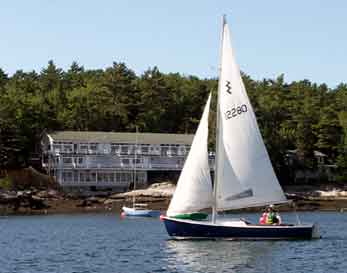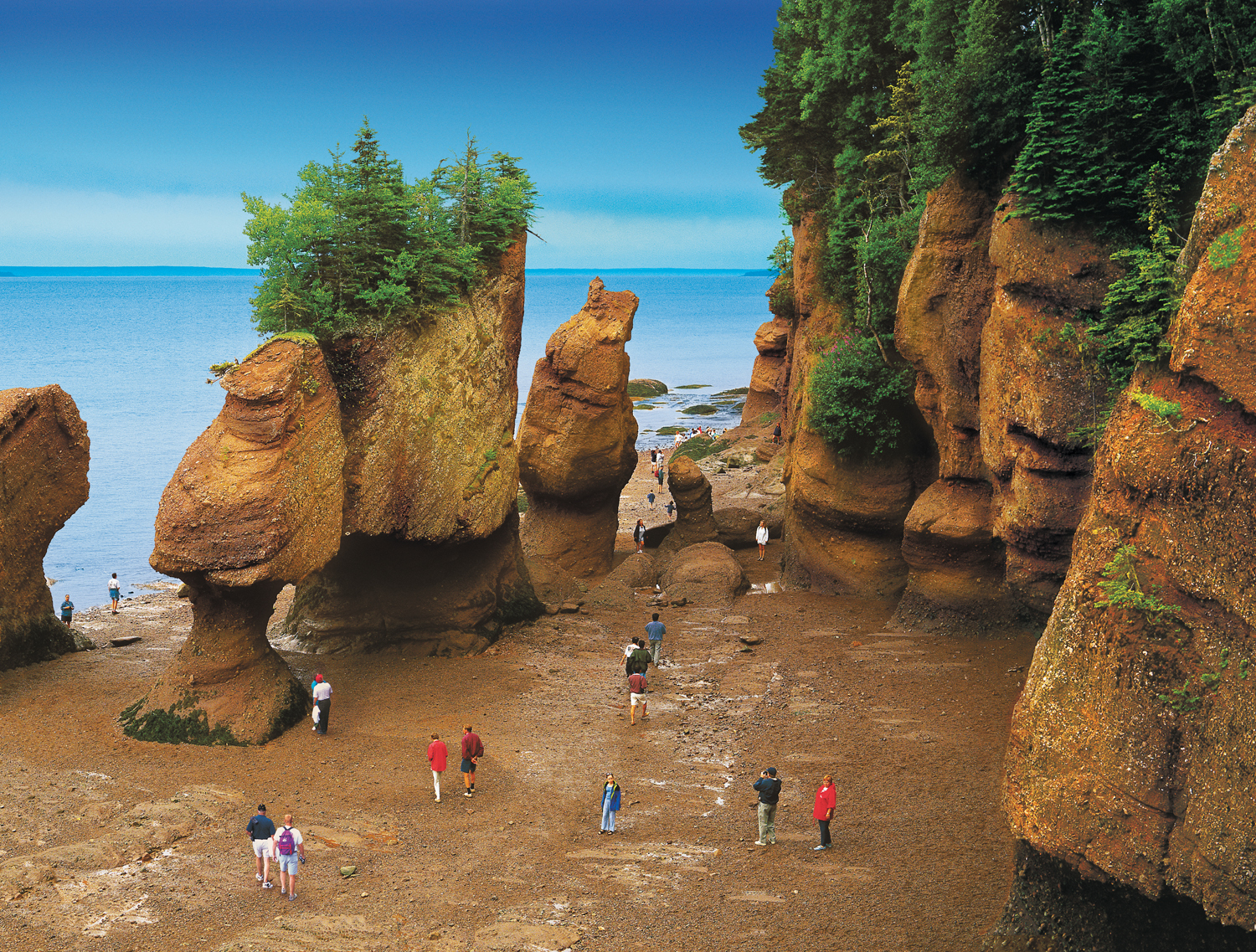Climb Mount Shasta, California
Climb Mount Moriah, Nevada
A four-hour drive from Salt Lake City, Great Basin National Park is a little-known gem where mountains over 13,000 feet rise dramatically from the desert floor. Wheeler Peak (13,063 feet) is the highest mountain in the park, but if you want diversity of terrain, local rangers suggest trekking the 11-mile Hendrys Creek Trail to the summit of 12,067-foot Mt. Moriah. The 5,000-foot vertical climb takes you through thickets of pinon pine and vast glades of aspen forest. At 11,000 feet, you reach the Table, Moriah’s rolling sky-high plateau. On the Table’s rim are stands of twisted bristlecone pines, which, at 3,000 to 4,000 years old, are the oldest type of tree on the planet. From here, it’s just a scramble up rocks to the summit. If visibility is good, you can look across an uninterrupted carpet of sagebrush for a good 100 miles.
Climb Katahdin
The sweltering days of summer is when my mind wanders to the lofty peaks of North America. Unless you like climbing with ice axe and crampons, this is the best time to bag a peak. This week, I’ll be discussing some of my favorite climbs in the States. First stop, mighty Mount Katahdin at Baxter State Park, Maine.
Surprising Buffalo
 At the turn of last century, Buffalo had more millionaires per capita than any city in America. The combined wealth helped persuade Louis J. Sullivan, Frederick Law Olmsted, and Frank Lloyd Wright to come to town to create skyscrapers, parks, and estates. Then the city fell on hard times. But it seems like Buffalo is having the last laugh. Money is staring to pour in to salvage many of their architectural highlights.
At the turn of last century, Buffalo had more millionaires per capita than any city in America. The combined wealth helped persuade Louis J. Sullivan, Frederick Law Olmsted, and Frank Lloyd Wright to come to town to create skyscrapers, parks, and estates. Then the city fell on hard times. But it seems like Buffalo is having the last laugh. Money is staring to pour in to salvage many of their architectural highlights. Travel to the G-Spot, by Steve Cohen
 I always equate Steve Cohen with his namesake, Sasha Baron Cohen. His irreverent musings as a travel writer have appeared in countless publications, including Outside, the Islands of yore (my favorite travel publication in the 90s), and The Washington Post. His mishaps as ordinary Joe caught up in some ridiculous travel circumstance always lead to uproarious results. That’s why I’m giddy with excitement to read his first novel, Travel to the G-Spot. Not surprisingly, it’s a fictional memoir of one Danny Gladstone, a 50-year-old travel writer who learns he’s dying and looks back through some of his travel stories to figure out why things have turned out the way they have. One reviewer said “it blows the lid off the sordid and secretive world of travel writing.” Oh yeah, I am so there. I’m taking it with me on my trip to Buffalo today to drop my son off at music camp. I’ll be back next Tuesday. In the meantime, keep laughing.
I always equate Steve Cohen with his namesake, Sasha Baron Cohen. His irreverent musings as a travel writer have appeared in countless publications, including Outside, the Islands of yore (my favorite travel publication in the 90s), and The Washington Post. His mishaps as ordinary Joe caught up in some ridiculous travel circumstance always lead to uproarious results. That’s why I’m giddy with excitement to read his first novel, Travel to the G-Spot. Not surprisingly, it’s a fictional memoir of one Danny Gladstone, a 50-year-old travel writer who learns he’s dying and looks back through some of his travel stories to figure out why things have turned out the way they have. One reviewer said “it blows the lid off the sordid and secretive world of travel writing.” Oh yeah, I am so there. I’m taking it with me on my trip to Buffalo today to drop my son off at music camp. I’ll be back next Tuesday. In the meantime, keep laughing.
In Every Season, Memories of Martha’s Vineyard, by Phyllis Méras

By the time I met Phyllis Méras over a decade ago, she already had an illustrious career as travel editor at the New York Times and Providence Journal. That’s not to say that she was retired by any means of the imagination. Over dinner, she would tell me about her travels to Europe or Africa, and her publishing efforts. Her latest book pays homage to her home of Martha’s Vineyard and it is perhaps her most personal work. She talks about how her great-grandfather, a French professor, came to the island in 1890s to teach at the Martha’s Vineyard Summer Institute. As managing editor at the Vineyard Gazette for six years starting in 1967, Méras met many of the island’s most famous residents, including Walter Cronkite, Beverly Sills, James Cagney, and Thomas Hart Benton. Yet, this book, exquisitely illustrated by her late husband, landscape painter Thomas Cocroft, and architect Robert Schwartz, details her walks in Menemsha to find ripe blackberries, paddling the often-overlooked ponds, and watching skunk cabbage rise in early spring. Take time to smell the roses with her in Edgartown and you’ll walk away with a finer appreciation of the island.
Nichole Bernier’s Debut Novel, The Unfinished Work of Elizabeth D.
 I’ve had the good fortune to work with talented editors who could tweak your stories seamlessly, only enhancing your voice. I’ve also known editors who were used as staff writers, creating well-crafted stories. But very rarely did I find an editor who could do both jobs well, edit and write. One of the few exceptions was Nichole Bernier, my former editor at Boston Magazine. She was a wonderful editor to work with, sculpting each one of my stories effortlessly. I also looked forward to reading her intriguing work. So it comes as no surprise that Nichole’s debut novel was just released by Crown Books. Actually, when you consider she’s now a mother of five, it’s a marvel that she had time to pen one paragraph, let alone a book The Washington Post recently praised: “Why do we keep secrets from those we love most? Is it possible for mothers and fathers to have it all — work and family? Bernier’s excellent storytelling skills will keep you pondering long after the final page.”
I’ve had the good fortune to work with talented editors who could tweak your stories seamlessly, only enhancing your voice. I’ve also known editors who were used as staff writers, creating well-crafted stories. But very rarely did I find an editor who could do both jobs well, edit and write. One of the few exceptions was Nichole Bernier, my former editor at Boston Magazine. She was a wonderful editor to work with, sculpting each one of my stories effortlessly. I also looked forward to reading her intriguing work. So it comes as no surprise that Nichole’s debut novel was just released by Crown Books. Actually, when you consider she’s now a mother of five, it’s a marvel that she had time to pen one paragraph, let alone a book The Washington Post recently praised: “Why do we keep secrets from those we love most? Is it possible for mothers and fathers to have it all — work and family? Bernier’s excellent storytelling skills will keep you pondering long after the final page.”Lovely Linekin Bay
 I’ve been writing about New England since 1994, even authoring a book titled New England Seacoast Adventures, so it’s rare when I find out about a classic resort on the New England coast I’ve never visited. But that was exactly the case this past weekend when I brought my family to Linekin Bay Resort on the Maine coast. Linekin Bay might be a five-minute drive from the tourist hub of Boothbay Harbor, but once you arrive, it feels a world away. A former girls camp when it opened over a century ago, you spend the night in lodges with grand stone chimneys and cabins perched on a bluff overlooking the ocean water. In the morning, you wake up to lobster boats pulling up their traps and then wander over to the main lodge for a breakfast of wild blueberry crepes, French toast topped with strawberries, eggs benedict, and hot-out-of-the-oven scones. All meals are included in the price, including the Tuesday lobster bake that’s held on the outdoor deck with live music. Other nights, the food is surprisingly good and includes swordfish, hangar steak, and roasted chicken.
I’ve been writing about New England since 1994, even authoring a book titled New England Seacoast Adventures, so it’s rare when I find out about a classic resort on the New England coast I’ve never visited. But that was exactly the case this past weekend when I brought my family to Linekin Bay Resort on the Maine coast. Linekin Bay might be a five-minute drive from the tourist hub of Boothbay Harbor, but once you arrive, it feels a world away. A former girls camp when it opened over a century ago, you spend the night in lodges with grand stone chimneys and cabins perched on a bluff overlooking the ocean water. In the morning, you wake up to lobster boats pulling up their traps and then wander over to the main lodge for a breakfast of wild blueberry crepes, French toast topped with strawberries, eggs benedict, and hot-out-of-the-oven scones. All meals are included in the price, including the Tuesday lobster bake that’s held on the outdoor deck with live music. Other nights, the food is surprisingly good and includes swordfish, hangar steak, and roasted chicken.
Sea Kayaking the Bay of Fundy
 On my last day in New Brunswick, I headed an hour drive southwest of Moncton to Fundy National Park. The Bay of Fundy is home to the highest recorded tides in the world, often in excess of 40 feet, so I’ve always wanted to check out the current on a sea kayak. In Alma, I met up with Fresh Air Adventures for a half-day jaunt along the rugged coast. We had to paddle against the winds on the way out to open water, looking at Nova Scotia across the bay. The big of body of water was quiet, no fishermen, no other sea kayakers, as we made our way along the shoreline. Tall spruce and firs stood tall atop the craggy rock. When we stopped at a deserted beach, we spotted deer. After a snack, we cruised with the current, practically surfing atop the waves back to town. Even with the strong current, the long sea kayaks were sturdy and I never felt like I was going to go for a dip in the frigid waters. For an encore, we stopped at Hopewell Rocks on the drive back to Moncton. The iconic image of the Bay of Fundy, the tall rocks are carved by the perennial surf and are always evolving. Often referred to as “flowerpot rocks,” many of the formations have trees sprouting out of the top, thus resembling flowerpots. We can check this one off the bucket list.
On my last day in New Brunswick, I headed an hour drive southwest of Moncton to Fundy National Park. The Bay of Fundy is home to the highest recorded tides in the world, often in excess of 40 feet, so I’ve always wanted to check out the current on a sea kayak. In Alma, I met up with Fresh Air Adventures for a half-day jaunt along the rugged coast. We had to paddle against the winds on the way out to open water, looking at Nova Scotia across the bay. The big of body of water was quiet, no fishermen, no other sea kayakers, as we made our way along the shoreline. Tall spruce and firs stood tall atop the craggy rock. When we stopped at a deserted beach, we spotted deer. After a snack, we cruised with the current, practically surfing atop the waves back to town. Even with the strong current, the long sea kayaks were sturdy and I never felt like I was going to go for a dip in the frigid waters. For an encore, we stopped at Hopewell Rocks on the drive back to Moncton. The iconic image of the Bay of Fundy, the tall rocks are carved by the perennial surf and are always evolving. Often referred to as “flowerpot rocks,” many of the formations have trees sprouting out of the top, thus resembling flowerpots. We can check this one off the bucket list. 